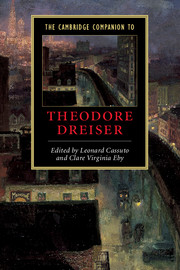Book contents
- Frontmatter
- Introduction
- Part I Backgrounds and contexts
- Part II Dreiser and his culture
- 5 The matter of Dreiser’s modernity
- 6 Dreiser, class, and the home
- 7 Can there be loyalty in The Financier? Dreiser and upward mobility
- 8 Dreiser, art, and the museum
- 9 Dreiser and women
- 10 Sister Carrie, race, and the World’s Columbian Exposition
- 11 Dreiser’s sociological vision
- 12 Dreiser and crime
- Select bibliography
- Index
8 - Dreiser, art, and the museum
from Part II - Dreiser and his culture
Published online by Cambridge University Press: 28 May 2006
- Frontmatter
- Introduction
- Part I Backgrounds and contexts
- Part II Dreiser and his culture
- 5 The matter of Dreiser’s modernity
- 6 Dreiser, class, and the home
- 7 Can there be loyalty in The Financier? Dreiser and upward mobility
- 8 Dreiser, art, and the museum
- 9 Dreiser and women
- 10 Sister Carrie, race, and the World’s Columbian Exposition
- 11 Dreiser’s sociological vision
- 12 Dreiser and crime
- Select bibliography
- Index
Summary
To many commentators of the early twentieth century, American culture seemed to have divided between, roughly speaking, the high and the low - between the high arts and popular culture, between spiritual values and materialistic ambitions, between the world of art and the world of business. Accepting for the moment this formulation, we could say that few modern writers lived as deeply in both realms as Theodore Dreiser. Dreiser was, to begin with, intimately connected with the art scene in New York City, having written many feature articles on leading artists during the 1890s, based on his visits to their studios. Yet in the next decade, following the publication of Sister Carrie (and its disappointing promotion and sales), Dreiser worked with great success in the publishing business, rising eventually to direct three popular women’s magazines for the Butterick Publishing Company. The two worlds of art and commerce came together in Dreiser, and they come together, from different directions, in the personalities of two major heroes in the fiction written after 1910: Frank Cowperwood (The Financier, The Titan, The Stoic), imperious as both a businessman and as an art collector; and Eugene Witla (The “Genius”), an immensely gifted artist who becomes editorial director for a major publisher.
- Type
- Chapter
- Information
- The Cambridge Companion to Theodore Dreiser , pp. 127 - 141Publisher: Cambridge University PressPrint publication year: 2004



